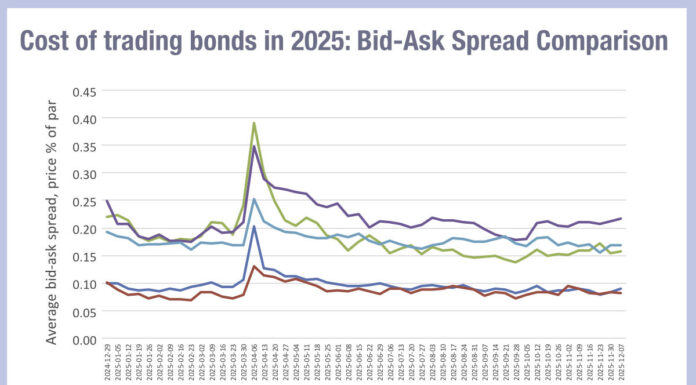Bond trading is a relationship business, with pricing and liquidity influenced by the strength of relationships between buy-side and sell-side. As the market moves towards a greater reliance on quantitative analysis and electronic execution, the nature of ‘trust’ changes.
Electronic trading performance is based on a model which requires validation against a benchmark. Voice trading is of course benchmarked, but the exchange between traders can carry far more information than the electronic matching of a trade based on parameters.
When we talk about trust in bond trading, in a sense we are talking about the leaps of faith that are made to bridge the gaps in limited or absent information. That trust is needed in pre-trade information and also at the point of trading. Taking a leap requires confidence in existing information, the experience needed to evaluate a path forward, and benchmarking using a wider picture of the market.
If trust takes a lifetime to build and a moment to lose, when a data provider does not meet expectations, how quickly is that trust eroded?
There are real cases to test this. Where price feeds were based on weaker than expected levels of market activity – in some cases just one trade to set a price – that has not totally eroded confidence in a provider.
The reasons are complex. Gaps in information are inherent in a bond market where some instruments only trade once a week or less, meaning that much of the quantitative data that is available is indicative, rather than absolute.
“If a price was wrong on an equity exchange, you would go absolutely fucking bananas, but if a price via a consolidated price feed was off, that is understood to only be an indication,” noted one senior trader.
Equally a data provider or a bank showing a price will have based that on a model, and if that model does not show a correct price it can be through either error or design.
“Models can have a bias – if it is pricing too aggressively it can be advantageous to a counterparty hitting or lifting it,” notes another head of trading. “A buy-side firm might trade against it for a short while, but then they will be cut off from it by the bank once it realises the model is not performing.”
If the model is deliberately skewed against the client – or even if it is careless in distribution of non-firm pricing and therefore generates noise – it can be quickly excluded by an asset manager’s trading desk.
“A model without a relationship is a guaranteed nightmare for the sell-side,” the trader says.
The reputational risk for that firm can be serious if its information is no longer trusted.
Of course, humans can also provide false information, and if a trader publishes a price or axe consistently, only to pull it when traded against, they can expect to be pulled over the coals for what could only be seen as a deliberately misleading information.
The effect that wrong information has – and the seriousness of a response – depends on how wrong it was and how deliberate it was.
A trusted counterparty should have personal motivation to engage honestly; a dealer wants to maintain their ability to win trades from a client, and a client wants to continue to access liquidity. That understanding means that mutually assured success is a shared goal.
Equally, but more abstractly, the price provided by a paid-for feed, or by data on a trading platform, is clearly trying to be as accurate as possible in order to maintaining the commercial relationship between the data feed / trading platform and the user. However, as a broader service provider the ‘trust’ is clearly less personal.
A sell-side trader will often be able to take clients with them if they move between firms, which makes the less personal nature of a data feed advantageous for the business providing the service.
Mutually assured success has another advantage – it is not a linear path of success. Dealers will sometimes take a hit for a client knowing that trust is being strengthened.
Potentially as data quality improves, allowing more decisions to be made based purely on quantitative information, the lack of day-to-day interpersonal trading contact will result in less meaningful relationships.
That change is not certain – e-trading levels are still constrained in the credit space relative to total volume – so a more likely scenario would be to see the voice/chat and e-trading continue to be used together.
Traders are also adamant about one thing; in unusually illiquid markets, relationships are the only way to source liquidity.
“In those circumstances the markets can’t keep up and the algos get switched off so there’s no alternative,” says a senior trader.
©Markets Media Europe 2023
©Markets Media Europe 2025















